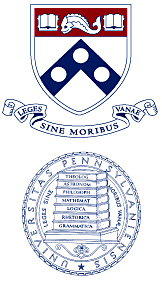The University’s seal has a curious history.
By Samuel Hughes

On December 5, 1900, Provost Charles Harrison C1862 received a letter from the assistant secretary of the University about a rather delicate matter: “the use of our seal as a trademark by a certain whiskey dealer of this city.” It wasn’t just that the entrepreneur in question had appropriated the seals of a dozen upscale universities for his booze; he had also registered them for his own purposes with the U.S. Patent Office.
But in Penn’s case, there was a catch. The seal used by “our enterprising friend,” wrote J. Hartley Merrick C1890, was the “old” seal, not the one that had been adopted earlier that year by the trustees. He suggested copyrighting the new seal at once, since the “trifling” cost “would be well expended in protecting the University from further faux pas of a similar nature.” The University took Merrick’s advice, and any connection between Penn and whiskey since then has been untainted by profiteering.
That new seal, incidentally, was the same one displayed by Old Penn in its 1903 logo. In it, the traditional stack of seven books was nearly encircled by the Latin words Literae sine Moribus Vanae. The first word was a recent addition, however. Until 1900, the motto had been Sine Moribus Vanae, part of a line from Horace’s Third Ode that read: quid leges sine moribus vanae proficiunt?—“of what avail empty laws without [good] mores?” The quotation had been chosen by William Smith for the title page of his A General Idea of the College of Mirania (which so impressed Benjamin Franklin that he picked Smith to be the first provost), and the three-word version had been used in most of the University’s seals from 1756 through the end of the 19th century.
But in 1898, some wag translated Sine Moribus Vanae as “Loose Women without Morals,” and all hell broke loose. The trustees, especially Horace Howard Furness, were aghast, and scrambled to find a fig leaf. Literae was pressed into service, transforming Horace’s wistful observation about laws and social mores into an epigram about education. The trustees also added the Penn family’s coat of arms to the bottom of the seal—a tip of the mortarboard to Thomas Penn, son of William Penn and the University’s colonial patron.
That version lasted until 1932. By then the University’s Committee on University Seal and a Coat of Arms had concluded that the design was “confused” and its motto unnecessarily “mutilated,” while the presence of the Penn family’s arms, with no university-identifying books in it, was a “violation of one of the fundamental rules of heraldry.” As a result, the trustees replaced Literae with Leges, restoring Horace’s original words while depriving naughty Latinists of a laugh at the University’s expense. They also dropped the Penn family’s shield.
Though its design has changed over the years, the seal is almost as old as the University itself. The first one used both the truncated quote from Horace and the “stack of books” motif, with the words Theolog, Astronom, Philos. Nat (later changed to Philosoph), Mathemati, Logica, Rhetorica, and Grammatica written on the books’ sides. Below that was the then-agreed-upon date of the College’s founding: MDCCL—1750—which is 10 years later than the University’s later historians would agree upon.
The seal used today—the first to use the word Leges in the motto—is the one adopted in 1932 and first used in 1933. That same year, the trustees also followed the committee’s recommendation to prepare a coat of arms, something the University had never had. The design for that, in the words of a 1965 pamphlet published by the Office of the Secretary, combines “the principal devices of the Penn and Franklin arms, the three plates and the dolphin respectively, with the University’s colors upon a white silver field,” while the two open books indicate an institution of learning. That coat of arms, the pamphlet noted, serves a “decorative rather than a legal function.” Ironically, Franklin and Thomas Penn soon came to detest each other. [For more on that, see “Your Most Obedient Servant: The Provost Smith Letters,” April 1997.]
None of this even touches on the “Orrery Seal,” which was designed in 1782 by Francis Hopkinson C1757 and incorporated into the President’s Badge (first worn at the inauguration of Dr. Sheldon Hackney Hon’93 in 1981). Hopkinson, a member of the College’s first graduating class who signed the Declaration of Independence, had plenty of experience designing seals and other symbolic representations. He was part of the committee that designed the Great Seal of the United States, and he personally designed the seals for the Admiralty and Treasury boards, asking (since he was then Treasurer of Loans) only to be paid for his work in wine—a request turned down by Congress.
And there was something else, too. According to Earl P. Williams, Jr., author of a number of articles and books on Hopkinson and American flags, “the overwhelming evidence suggests that Hopkinson designed the Stars and Stripes by himself.” Yes, those Stars and Stripes.
But that’s another story.

